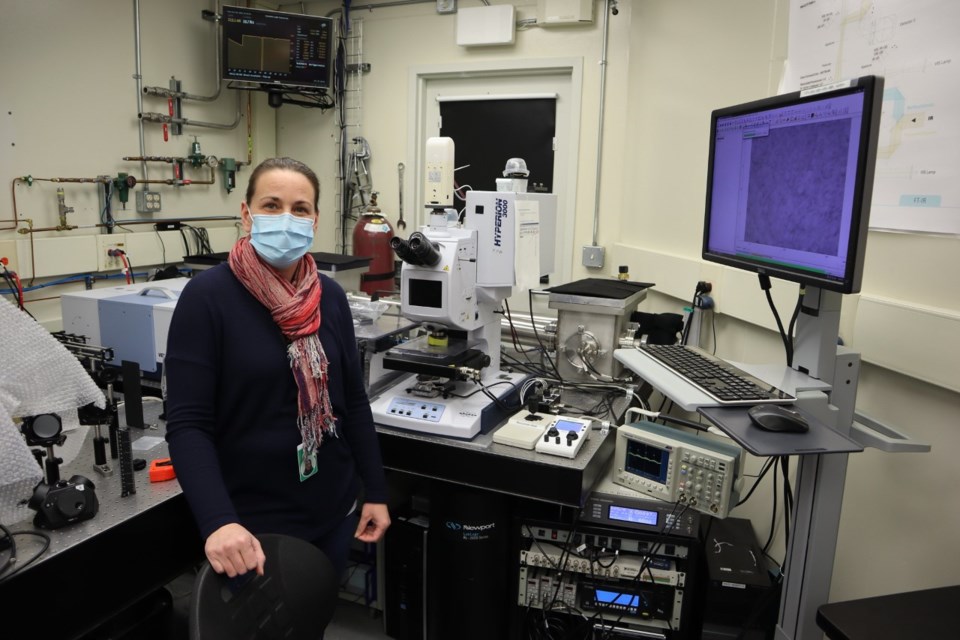It never ends.
As we age the wear and tear is noticed most often in our bodies. The knees get creaky, the hips get sore and don't even mention that aching back.
But those are not the only things that tend to get a little slower with age.
It can get harder as we age to recall the name of that guy who helped with the whatchamacallit when the doohickey broke on the thingamajig on Sunday. Or was it Monday?
The old noggin could use a little help most days.
Dr. Kendra Furber, assistant professor, UBC Northern Medical Program and the Division of Medical Sciences at UNBC, is looking to pinpoint the causes of brain aging and how to prevent or even reverse the damage that occurs over time.
Myelin degradation is one of the contributing factors to these lapses in memory and cognition. Myelin is a fatty substance which covers the neurons in your brain and spinal cord, helping to insulate the connections between cells and allowing lightning-fast information to flow through the nervous system.
"My research is focused on myelination in the brain," Furber said. “Our brains continue to myelinate until midlife and then the volume and integrity of that myelin starts to decline. This often correlates with deficits in memory and cognitive processing speed."
Furber and her team have been using the Mid-IR beamline at the Canadian Light Source (CLS), the University of Saskatchewan, to look at biochemical changes in the brain.
The CLS is a national research facility, producing the brightest light in Canada - millions of times brighter than even the sun. The faclity annually hosts more than 1,000 scientists from around the world who use the light to conduct ground-breaking health, agricultural, environmental and advanced materials research. The Mid-IR beamline is ideal for studying biomedical and biological materials, as well as other types of samples.
Furber has focused her attention on specialized cells in the brain that form the myelin sheath. The myelin-producing cells look a little bit like an octopus with multiple tentacles that wrap around neurons, providing them with the insulation they need, she explained. As they age, the tentacles wither, leaving cell connections unprotected. The researchers hope to understand why the myelin starts to decline with age, she added.
“At some point some of that myelin is lost and we get less and less efficient at repairing it,” Furber said. “It’s kind of this balance and it gets tipped to more myelin loss as we age - we’re not making those new connections or wrapping up the nerve processes as well.”
The brain likes to rewire pathways when we are learning new skills, what scientists refer to as neuroplasticity. As we age, the brain is not as flexible and rewiring pathways becomes more difficult, leading to changes in learning and memory.
Furber and her team are currently looking at strategies to help make our brain cells more resilient to environmental stress. Data shows that simple things like exercise, sleep, and a proper diet may help keep our myelin healthy.
“We’re interested in fat metabolism and diet and to understand if those things can make a difference in making those myelin-producing cells more resilient to damage or degeneration,” Furber said.
The team found that there is distinct changes in the fat composition in the myelin with age which has been recently published in the scientific journal Neurochemical Research. To find the root cause, the researchers are further investigating the important roles of certain genes in the myelination process.
The Mid-IR beamline at the CLS allows Furber and her team to push the boundaries of their research, helping them to see results in greater detail and to learn more about how changes in the brain impact myelin formation and degeneration.
“We started trying some really interesting stuff using the synchrotron light,” Furber said. “The beamline scientists are the ones that are really pushing these new methods and now I get to think up all the fun questions that we wouldn’t be able to ask using our normal microscopes in our lab.”
This research is funded by Michael Smith Foundation for Health Research (MSFHR) scholar award, Natural Sciences and Engineering Research Council of Canada (NSERC), and Saskatchewan Flax Development Commission and Furber said she's very grateful for it.
Named a 2021 Michael Smith Foundation for Health Research (MSFHR) scholar, Furber is one of 32 researchers across the province to receive the award of $90,000 a year for five years from MSFHR which is BC’s health research funding agency. The scholar program offers support to researchers who are in the early stages of their career as they work to develop their programs and build their research teams.



.png;w=120;h=80;mode=crop)